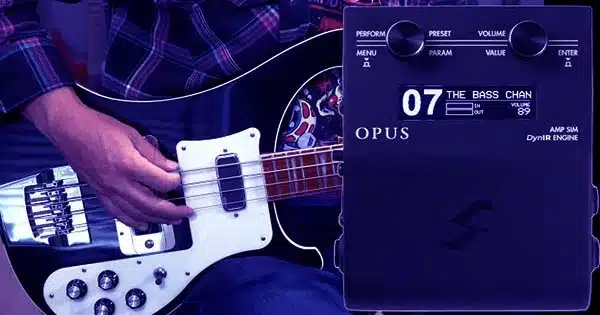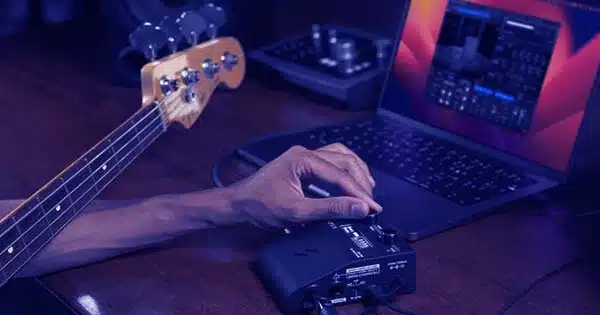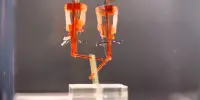Opus Two Notes Review: If you’re a guitarist who wants to record, you’ve probably heard about Two Notes. The French company is well-known for producing excellent recording gear for guitarists and producers. In my home studio, I have a Two Notes Torpedo Captor X load box. As a result, I was ecstatic to learn that Two Notes had developed an all-in-one, end-to-end hardware modeling solution.
Two Notes isn’t the first company to provide an all-in-one direct recording solution. We were introduced to the ReVolt guitar and bass amp-simulation pedals earlier this year. However, these are all analog units with limits, particularly in the realism of cabinet modeling. Enter the Two Notes Opus: an all-digital, tiny, self-contained unit that provides preamp, power amp, and speaker cabinet emulation all in one small, portable package.

Normally, I don’t bring up product pricing until the end of a review, but in this situation, I believe it’s critical right away. The Two Notes Opus will be available at around $299.99, which is an extremely competitive pricing point. At a glance, it undercuts practically all of the “amp in a box” rivals in terms of pricing. It also directly headbutts the recently released Line6 HX One. Given the price, it’s probably best to think of the Opus as a utility product rather than a “multi-effects” device.
The Pedal that’s not a Pedal: So, what is the Two Notes Opus? I must admit that I was taken aback when Two Notes sent along the initial press bundle for this item. The Opus is the size and shape of a pedal, and its form factor is ideal for throwing on your pedalboard. However, you will see that there is no footswitch! I asked Two Notes about this design decision and, as a result, to whom the unit was marketed. The Opus is designed to work as a supplement to your existing pedalboard/amp setup or as a solo practice instrument.
This design choice makes sense when placed at the end of your pedalboard as a “virtual amp in a box” or between your head and cab as a cab modeller. However, I can’t help but think that a single footswitch would have greatly increased the adaptability.
TSM Preamp Emulation: TSM Preamp Emulation is a new DSP-powered technology from Two Notes that is used in the Opus. This is the first time TSM has been included in a product, allowing for the “end-to-end” modeling system seen here. There are preamps, models, and simulations for electric, acoustic, and bass guitarists alike.
TSM seeks to emulate the tone and feel of various well-known amplifier pre-amp sections:
- Foundry: A “California Clean” amp tone that is definitely inspired by Fender amplifiers.
- Peggy: A bassist yearning for that Ampeg-style snarl and punch.
- Albion: Marshall crush for days, Albion!
- Foxy: Foxy is a VOX-style preamp with the chime and drive of VOX AC amplifiers.
- NiftyFifty: NiftyFifty is a high-gain, aggressive amp preamp that is ideal for metal rhythms and leads. I’m not sure what this is based on, but it reminded me of Mesa/Soldano in its personality.
The DynIR Engine: Anyone who has used Two Notes products such as the Torpedo Captor will be familiar with the DynIR Engine. DynIR provides very convincing power amplifier, cabinet, and microphone emulations. According to Two Notes, DynIR provides the equivalent of 160,000 studio-grade IR files. Each DynIR reaction can be highly customized. A variety of modeled microphones provide virtual dual mic-ing choices; there are theoretical 10K mic placements (front & back) available.
Because of my personal Torpedo Captor X’s expertise, I’ve already spent a significant amount of time with DynIR. Obtaining a truly realistic mixed cab tone is critical to the realism of any amp emulation. According to my previous experiences, the addition of DynIR is a significant selling factor for Opus.
Well Connected: Two Notes has decided to leave the Opus as a mono unit; at this price point and with the emphasis on amp modeling, this makes sense. An input jack on the right side of the unit can be changed to an amplifier, line, or instrument level. It’s worth noting that the Opus is not a load box like the Torpedo Captor. The through socket, on the other hand, allows you to position the Opus between your head and cabinet (or load box). A USB-C connector and the power supply input are connected to those connections.
The ingenious integration continues on Opus’s left side. There is a 1/4′′ line out as well as a balanced XLR output with ground lift. Then there are three 3.5mm jack sockets: aux-in, headphones (excellent for practice), and a MIDI-in. The latter may negate the lack of foot switching, as the Opus can be controlled via MIDI.
A good, crisp monochrome OLED display can be found on the unit’s top edge. Two rotary encoders on either side of the display provide access to patching and editing. Finally, the back panel includes a micro SD card slot for storing the IRs and models. When powered on, the entire back panel shines with the Two Notes logo, which looks classy and sophisticated.
Listening Test
Before beginning our Two Notes Opus review, I connected the Opus to my audio interface and studio monitors via the balanced XLR output. Notably, I tested with two guitars: a Fender Telecaster Crafted in Japan and a Gibson Les Paul Standard.
Without a doubt, if a modeller or effects unit does not sound excellent or inspire me as a player, I quickly lose interest. No number of bells and whistles can compensate for a lack of tone or emotion. I come from the old school of “tube amp and cab” players. Without a doubt, I’m always looking for the same things: tone, touch sensitivity, dynamics, and an inspiring playing sensation.
Sound Check: Before beginning our Two Notes Opus review, I connected the Opus to my audio interface and studio monitors via the balanced XLR output. Notably, I tested with two guitars: a Fender Telecaster Crafted in Japan and a Gibson Les Paul Standard.
Without a doubt, if a modeller or effects unit does not sound excellent or inspire me as a player, I quickly lose interest. No number of bells and whistles can compensate for a lack of tone or emotion. I come from the old school of “tube amp and cab” players. Without a doubt, I’m always looking for the same things: tone, touch sensitivity, dynamics, and an inspiring playing sensation.
I’m pleased to report that the Two Notes Opus does not disappoint in terms of sound. I began by going through the factory settings, which included blues, funk, rock, metal, and other genres. As with any good piece of music technology, I quickly lost track of time. A good modeller makes you forget you’re playing through one and just enjoy yourself, as was the case here!
One of the most difficult sounds to replicate properly is that of a tube amp and cabinet on the verge of breaking apart. Two Notes’ algorithms are particularly effective in this area; I had the impression of solely picking intensity driving a little combo into disintegration. High-gain players will be pleased as well; there are some wonderful metal tones available here, with good articulation and body.
Patch Editing: It is totally possible to modify a patch without a computer using the Opus as a standalone device. The two rotary encoders allow you to traverse menus in a natural way. The OLED screen is bright and crisp, and the images guide you through the process in a straightforward manner. When I tested it out, the built-in tuner seemed incredibly responsive and accurate.
To get the most out of the Opus, I recommend utilizing the Two Notes Torpedo Remote app. You may link the opus to your computer via USB or Bluetooth to your smartphone/iPhone/tablet, etc. The Bluetooth-connected iOS app was not accessible to me at the time of the review. I was, however, able to test the Torpeo Remote app on my MacBook Pro.
It’s when you use the app that the app’s overwhelming “tweakability” shines through. I had a lot of fun moving about the virtual microphones, trying out different cabinets in different acoustic locations, and experimenting with different pre and power amp combinations. The software is highly user-friendly and adds yet another layer of capability to the Opus.
Matchless Modeling?
When compared to modeling solutions from major providers such as Universal Audio, Headrush, and Line6, the Two Notes models perform admirably. If I had one issue, it would be that the power amp modeling isn’t as precise as competitors. This is possibly a compromise in the architecture of Two Notes. Preamplifiers have amplifier-specific correct models, whereas power amplifier models are more generic. This is far from a deal-breaker, and it actually offers potential adaptability.
Do you want to combine a Marshall-style preamp stage with an EL-84 power amp stage? Not a problem! In fact, you can build pre-amp, power amp, and speaker combinations that would be impossible to build in real life.
I should also note the fantastic FX engine. If you’re searching for modulation and deep-dive creative effects, you could be let down. The quality of the reverbs, dynamics, and EQ will not disappoint you. They’re a substantial addition to the Opus and, at this price range, not to be overlooked.
An indispensable tool: I’ve been asking myself the same question throughout this review: how can a suite of useful software and hardware features be accessible in a package this small and at this price? As a touring and recording guitarist, I can easily recall plenty of scenarios where the Opus would have come in handy. The fact that it also produces credible and pleasurable amp tones is the icing on the cake.
If you’re looking for the ultimate in “amp in a box” authenticity, the UAFX amp modellers still win. However, you’ll spend more for a unit that’s significantly less versatile and lacks a balanced DI. For most guitarists, the added versatility and lower price point will always win out.
Reservations? So, I’ll return to the exclusion of footswitch control once more. Yes, you may change patches and so on using MIDI or the app. A single footswitch to turn the unit on or off, or to switch between two user-assignable patches, would have elevated this to a “five-star product.” Similarly, a patchable effects loop would have been on my wish list. I’m sure many of us like to use modulation-based effects after the pre-amp but before the power amp.
However, given the price, these are merely “wish list” items. Maybe Two-Notes will consider making an “Opus XL” with a few footswitches and an effects loop. That would truly be a dream come true!















